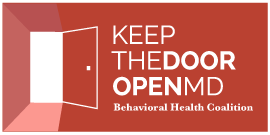Download the 2021 Keep the Door Open Policy Agenda here.
As Maryland continues working to respond to the death and disruption caused by the coronavirus, the state must also grapple with a corresponding increase in COVID-19-related mental health and substance use disorders. Up to 40% of Marylanders have reported feeling anxious or depressed as a result of the pandemic, and state crisis hotlines are receiving a startling increase in calls from individuals at risk for suicide2. Drug-and-alcohol-related deaths jumped by more than 18% in the second quarter of 2020 as compared to the same period a year earlier, including a 30% increase in opioid-related deaths.
And as with COVID-19, this behavioral health crisis will disproportionately affect Black and Hispanic individuals, older adults, lower socioeconomic groups of all races and ethnicities, and health care workers. In June, the Centers for Disease Control and Prevention (CDC) found significantly higher suicide risk among racial/ethnic minority groups, unpaid caregivers for adults, and essential workers.
This parallel pandemic, coupled with a looming and potentially long-term state budget crisis, is poised to have a devastating impact on families across Maryland. Meeting the challenge will require a comprehensive strategy, smart investment and efficient use of resources. Accordingly, the Maryland Behavioral Health Coalition calls on our elected officials and agency leaders to take the following actions in 2021:
INVEST EQUITABLY IN THE BRAIN AND THE BODY.
People with mental health and substance use disorders drive high health care costs, yet less than 5% of total health care spending is directed toward behavioral health treatment. Maryland has taken steps in recent years to address this longstanding inequity through a series of statutory provider rate increases, but a dire budget situation is threatening to reduce or eliminate those gains. At this time of increasing demand, any divestment in community behavioral health services would be counterproductive and harmful, both budgetarily and in human costs. We must preserve FY21 and FY22 budget commitments to prevent a reduction in access to mental health and substance use treatment.
INVEST SMARTLY TO ENSURE QUALITY CARE.
Rising demand for behavioral health treatment and decreasing state revenues require greater creativity in how Maryland pays for and delivers public mental health and substance use disorder services. A movement toward value-based, outcome-focused service delivery in the state’s public behavioral health system will improve care quality and cost predictability at this critical moment. We must take steps to expand value-based payment methodologies, implement uniform systemwide measurement-based care standards, and increase provider flexibility to ensure a more patient-centered system of care.
ADDRESS RACIAL INEQUITIES IN THE DELIVERY OF BEHAVIORAL HEALTH CARE.
Racial and ethnic minorities have less access to behavioral health services than White people, are less likely to receive needed care, and are more likely to receive poor-quality care when they are treated. Troublingly, although this results in a disparate criminalization of minorities with behavioral health disorders, incarcerated people of color are less likely to be identified as having a behavioral health disorder8 and less likely to receive treatment9. We must identify and address system failures and structural issues that result in racial and ethnic minorities with behavioral health disorders being more likely than their white counterparts to be channeled into the criminal justice system versus treatment programming.
EXPAND ACCESS BY MEETING PEOPLE WHERE THEY ARE.
Increased flexibility around the delivery of telehealth has enabled Marylanders to access behavioral health treatment from their homes and on their phones. This service expansion has become a vital part of Maryland’s continuum of care. Likewise, remote school-based behavioral health services have helped Maryland students cope with the loneliness, depression, and anxiety that accompanies a prolonged state of isolation. But as kids return to the classroom, the current service capacity will not be enough to meet the need. We must maintain critical telehealth service flexibilities and expand school behavioral health supports.
PROVIDE SUPPORTS AND SERVICES TO THOSE MOST AT-RISK.
Maryland has battled a persistent opioid crisis and rising suicide rates since well before COVID-19, but pandemic-related stress, grief and despair are exacerbating these concerns. According to the CDC, over 1 in 10 individuals nationally has seriously considered suicide in the previous 30 days – including over 25% of those aged 18-24 – and over 13% have started or increased their substance use to cope with stress from the pandemic10. We must expand overdose and suicide prevention efforts, increase Maryland’s behavioral health crisis response capacity, and ensure sufficient access to peer support services and adequate behavioral health provider networks.
Look up your elected officials here.
